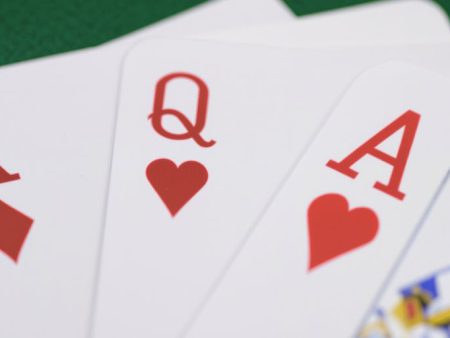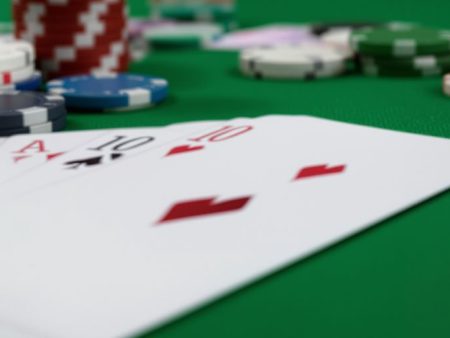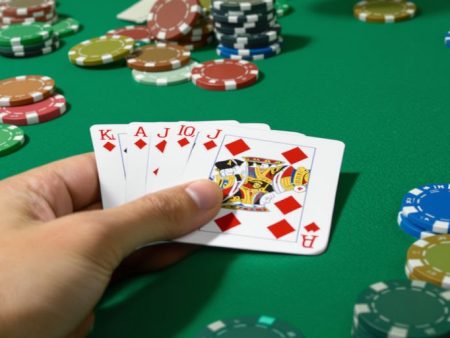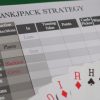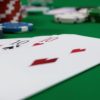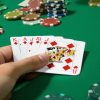So, you want to get better at blackjack? It’s a fun game, but knowing what to do with your cards can make a big difference. That’s where strategy charts come in. They might look a bit confusing at first, but they’re really just a map to help you make the best move in almost any situation. This guide will show you how to use a blackjack strategy chart to improve your game.
Key Takeaways
- A blackjack strategy chart shows you the statistically best move (hit, stand, double, split, or surrender) based on your hand and the dealer’s upcard.
- Understanding chart symbols like H (Hit), S (Stand), DH (Double Down), and SP (Split) is key to using the chart effectively.
- Mastering hard and soft totals, as well as knowing when to split pairs, are core components of basic strategy.
- Table rules, such as whether the dealer hits or stands on soft 17, can slightly alter the optimal strategy.
- Consistent practice with charts, drills, and quizzes is the best way to memorize and implement blackjack strategy correctly.
Understanding Blackjack Strategy Charts

So, you want to get better at blackjack? That’s awesome! Forget just guessing or going with your gut; there’s a smarter way to play. It’s called using a blackjack strategy chart. Think of it like a cheat sheet, but for math. It tells you exactly what to do in almost any situation you’ll face at the table. It’s not magic, but it’s pretty close to it for improving your odds.
What is a Blackjack Strategy Chart?
Basically, a blackjack strategy chart is a grid. On one side, you’ve got your hand total, and on the other, you’ve got what the dealer is showing. The chart then tells you the best move to make. It’s all based on math, figuring out the statistically best play to minimize the house’s advantage. It’s not about luck; it’s about making the smart play every single time. These charts are your roadmap to playing blackjack like a pro.
How Charts Improve Your Gameplay
Using a chart isn’t about being a robot; it’s about playing smarter. When you follow the chart, you’re making decisions that, over thousands of hands, will cost you less money than just playing however you feel like it. It helps you avoid those costly mistakes, like hitting a hard 16 against a dealer’s 10. That’s a big no-no, and the chart will tell you to stand. It takes the guesswork out of it, which is a huge relief when you’re sitting there with your money on the line. You’ll find yourself winning more often, or at least losing less, which is a win in my book.
Key Actions: Hit, Stand, Double, Split
These are the main moves you’ll see on the chart:
- Hit (H): You want another card. Simple enough, right?
- Stand (S): You’re happy with your hand and don’t want any more cards.
- Double Down (DH/DS): This is a cool one. You get to double your bet, but you only get one more card. It’s a big move, so you only do it when the odds are really in your favor. DH means double if the rules allow it; if not, just hit. DS means double if allowed, otherwise stand.
- Split (SP): If you get a pair, like two 7s, you can split them into two separate hands. You’ll get a new card for each, and you’ll have two chances to win. Some pairs are always good to split, others not so much. The chart tells you which.
- Surrender (SU): This is less common, but sometimes the chart will tell you to surrender. It means you give up half your bet and fold your hand. You only do this when your hand is really bad and the dealer’s upcard is strong. If surrender isn’t allowed, the chart will tell you to hit instead.
Decoding the Chart Symbols
Alright, let’s break down what all those letters and symbols on a blackjack strategy chart actually mean. It can look like a secret code at first, but it’s really just a shorthand for the best move to make in any given situation. Understanding these symbols is your first real step to playing smarter.
Understanding Hit (H) and Stand (S)
These are the most basic actions you’ll see. ‘H’ means Hit, which is pretty straightforward – you want another card. ‘S’ means Stand, meaning you’re happy with your current hand total and don’t want any more cards. It’s like saying ‘I’m good’ or ‘Give me more!’ Simple, right?
The Power of Doubling Down (DH/DS)
Doubling down is a special move where you double your bet and get exactly one more card. It’s a way to capitalize on a strong starting hand. You’ll see ‘DH’ (Double if allowed, otherwise Hit) and ‘DS’ (Double if allowed, otherwise Stand). This means if the rules don’t let you double in that specific spot, you should just do the next best thing, which is either hit or stand.
When to Surrender (SU)
Surrender is less common but still important. ‘SU’ means Surrender. This is when you give up half your bet and fold your hand, usually because your starting hand is really bad and the dealer’s up card looks strong. It’s a way to cut your losses. Sometimes you’ll see variations like ‘Rh’ (Surrender if allowed, otherwise Hit) or ‘Rs’ (Surrender if allowed, otherwise Stand), similar to doubling down. It’s a strategic retreat, not a sign of weakness, you know?
Mastering Hard Totals
Alright, let’s talk about those hands that don’t have an Ace, or where the Ace has to be a 1. These are your ‘hard’ totals. They can feel a bit more straightforward because there’s no flexibility with the Ace. You know exactly what you’ve got. It’s like looking at a fixed number, no guessing games with the Ace’s value. This section is all about making the right call based on your total and what the dealer is showing. It’s not always obvious, you know? Sometimes you’ll look at your 12 and the dealer’s 3 and think, ‘Stand, obviously!’ But nope, the chart says hit. Trust the chart, it’s seen more blackjack hands than you or I ever will.
Navigating Hands from 4 to 8
Honestly, these low totals are pretty simple. You’re almost always going to hit. Why? Because you need more cards to get closer to 21. There’s very little risk of busting with such low numbers. So, if you have a hard 4, 5, 6, 7, or 8, just hit. It’s the smart play. Don’t overthink it.
Strategic Decisions for 9, 10, and 11
Now we’re getting somewhere! These are your prime doubling down spots. A 9 is good, but double it against a dealer’s 3 through 6. A 10 is even better; double it against anything from a 2 through a 9. And an 11? That’s pure gold. You want to double down against any dealer card from a 2 all the way up to a 10. This is where you can really make the dealer sweat. If doubling isn’t allowed, then you hit on a 9 and 10, and double down (or hit if doubling isn’t an option) on 11.
Playing Hands from 12 to 16
This is where it gets a little tricky, and you really need to pay attention to the dealer’s upcard. For a hard 12, you stand if the dealer shows a 4, 5, or 6. Any other card? Hit. With a 13, 14, 15, or 16, you stand if the dealer shows a 2 through 6. If the dealer has a 7 or higher, you hit. It’s a bit of a gamble, but the chart tells you the best odds. You’re trying to avoid busting, but also trying to improve your hand when the dealer is likely to bust.
Standing on 17 to 21
Easy peasy. If your hard total is 17, 18, 19, 20, or 21, you always stand. You’ve got a strong hand. There’s no reason to risk hitting and busting. Just sit back and let the dealer do their thing. You’ve played this part perfectly.
Conquering Soft Totals
Alright, let’s talk about soft hands. These are the ones with an Ace, where that Ace can be an 11 or a 1. It’s like having a wild card, but it’s not always as straightforward as you might think. Getting a soft hand can feel like a real win, but you gotta know what to do with it. It’s not just about hoping for a good card; it’s about making the smartest move based on what the dealer’s showing.
Understanding Soft Hands
A soft hand is any hand that includes an Ace that can be counted as 11 without busting. So, an Ace and a 6 (totaling 17) is a soft 17. If you hit and get a 4, your hand becomes a 7 and a 6 (totaling 13), which is now a hard 13 because the Ace has to be a 1 to avoid busting. This flexibility is what makes soft hands so interesting and, frankly, a bit tricky.
Optimal Plays for Soft 13-15
When you’ve got a soft 13, 14, or 15, the chart generally tells you to hit. But wait, there’s a twist! If the dealer is showing a 5 or a 6, you should double down. Why? Because those dealer upcards are weak, and you want to get more money on the table when you have a good chance of winning. It’s a calculated risk, but it pays off over time. Don’t be shy about doubling here; it’s a key part of the strategy.
Strategies for Soft 16-18
Now, things get a little more nuanced with soft 16, 17, and 18. For a soft 16 (Ace-5), you’re looking to double down against dealer upcards of 4, 5, or 6. Any other dealer card? You hit. With a soft 17 (Ace-6), you double against 3 through 6. If the dealer shows anything else, you hit. The real sweet spot is soft 18 (Ace-7). This is where you want to double down against dealer cards 2 through 6. If the dealer shows a 9, 10, or Ace, you hit. Otherwise, you stand. It’s all about capitalizing on those dealer weaknesses.
Standing on Soft 19-21
Finally, soft 19 (Ace-8) and soft 20 (Ace-9) are hands you almost always want to stand on. The only exception for soft 19 is if the dealer shows a 6, in which case you double down. For soft 20, you just stand, no matter what the dealer has. These are strong hands, and you don’t want to risk busting them by hitting. You’ve got a great chance of winning with these totals, so just sit back and let the dealer do the work.
Strategic Splitting of Pairs

Splitting pairs in blackjack is where things get really interesting. It’s not just about having two of the same card; it’s about knowing when that pair is a golden ticket to a better hand, or when it’s a trap. Think of it like this: you’ve got a pair of 8s, which is a terrible 16. But if you split them, you’re starting two new hands, each with an 8. That’s a much better starting point, right? The key is to split pairs that give you a significant advantage when played as two separate hands.
Identifying Favorable Splits
Not all pairs are created equal, and not all pairs should be split. The decision hinges on your two cards and what the dealer is showing. Some pairs are almost always a split, while others depend heavily on the dealer’s up card. It’s all about maximizing your chances to win more money over time. You want to turn potentially weak hands into strong ones, and strong hands into even stronger ones.
When to Split Aces and Eights
Let’s talk about the superstars of splitting: Aces and Eights. You should always split a pair of Aces. Why? Because an Ace is a powerful card, giving you a chance at blackjack or a soft 17. Starting two hands with an Ace is a fantastic opportunity. Now, Eights are a bit different. A pair of 8s gives you a total of 16, which is a pretty rough spot to be in. Most of the time, you’ll be hitting and hoping not to bust. But when you split those 8s, you’re creating two hands that start with an 8. This is generally a much better situation than sticking with a 16, especially against certain dealer up cards. It’s a move that pays off in the long run.
Splitting Pairs 2, 3, 6, 7, 9
These pairs require a bit more finesse. For 2s and 3s, you want to split them against most dealer up cards, usually from a 2 through a 7. It’s a good way to get a better start. A pair of 6s is similar; split them against dealer cards 2 through 6. Anything else, and you’re probably better off hitting. Now, 7s are another pair you’ll split against dealer cards 2 through 7. It’s a solid play. Nines are a bit more selective. You’ll split 9s against dealer cards 2 through 9, but you stand if the dealer shows a 10 or an Ace. It’s a smart move that can really help your bottom line.
When Not to Split Pairs
There are definitely times when splitting is a bad idea. For instance, you should never split a pair of 5s. A pair of 5s gives you a hard 10, which is a great starting point for doubling down. Splitting them would turn that into two hands starting with 5s, which isn’t nearly as good. Also, pairs of 4s are tricky. You only split 4s against a dealer’s 5 or 6. Any other card, and you just hit. And remember, pairs of 10s (like two face cards or a 10 and a face card) are never split. You already have a strong 20, so why break it up?
Leveraging Doubling Down Opportunities

Doubling down. It’s a move that can really boost your bankroll when you get it right. Think of it as a power play in blackjack. You get to double your bet, but you only get one more card. It’s a big commitment, so you want to make sure you’re doing it when the odds are really in your favor. This is where your strategy chart becomes your best friend. It tells you exactly when to pull the trigger.
When to Double Down
Generally, you want to double down when you have a strong starting hand, usually a total of 10 or 11. Why? Because you have a really good chance of drawing a 10-value card (which are plentiful in the deck) to give you a great total of 20 or 21. It’s also a smart move when the dealer is showing a weak upcard, like a 5 or a 6. These cards give the dealer a higher chance of busting, meaning they’ll go over 21. So, you’re doubling your bet when you have a good hand and the dealer is likely to lose.
Doubling Down Restrictions
Now, not every table plays by the same rules. Some places might limit when you can double down. For instance, they might only let you double on a total of 10 or 11. This is a bummer for players because it takes away some of the best opportunities to use this move. Always check the table rules before you sit down. It’s a small thing, but it can affect your game. Some tables might also restrict doubling after you’ve split a pair. That’s another thing to watch out for.
Maximizing Advantage with Doubling
So, how do you really make this work for you? It’s all about following that chart. For example, if you have a hard 11 (two cards that add up to 11, not including an Ace counted as 11), you should almost always double down, especially if the dealer’s upcard is anything from a 2 to a 10. If you have a hard 10, you should double against any dealer upcard from a 2 to a 9. These are specific situations where the math really favors you. It’s not just a guess; it’s a calculated move to get the most out of a good situation. Remember, doubling down is a way to get more money on the table when you have a strong statistical edge. Don’t be shy when the chart says to do it!
The Role of Surrender in Strategy
Sometimes, the smartest play in blackjack isn’t to hit, stand, split, or double. It’s to fold. That’s where the surrender option comes in. It’s not a sign of weakness, but a calculated move to save some of your bet when the odds are really stacked against you. You give up your hand, and you get half your original bet back. Pretty simple, right? But not all tables offer this. Always check the rules before you sit down. It’s a game changer if it’s available.
Understanding the Surrender Option
Surrendering is basically saying "I’m out" before the dealer finishes their turn. You forfeit your hand, but you keep half of what you bet. This is a move you make when your hand is looking really bad, and the dealer’s upcard suggests they’re probably going to win. It’s a way to minimize your losses. Think of it like cutting your losses before they get too big. It’s a strategic decision, not a sign of giving up.
When Basic Strategy Recommends Surrender
Basic strategy charts tell you exactly when to surrender. It’s not random; it’s based on math. Here are the main times you’ll see surrender recommended:
- Hard 16: You should surrender this hand if the dealer is showing a 9, 10, or an Ace. Your chances of winning are pretty slim here, and surrendering saves you from likely losing the whole bet.
- Hard 15: This is a bit more specific. You generally surrender a hard 15 only when the dealer is showing a 10. Some rulesets might have you surrender it against an Ace too, but that’s less common.
It’s important to remember that surrender is usually only an option on your first two cards. You can’t hit, get another card, and then decide to surrender. It’s an early decision.
Impact of Surrender Availability
The availability of surrender can actually change how you play other hands. If a casino offers "early surrender" (where you can surrender before the dealer checks for blackjack), that’s even better for the player. However, most places offer "late surrender," which is after the dealer checks. Either way, knowing when to use it is key. If your table doesn’t offer surrender, you just revert to the standard hit or stand rules for those hands. It’s a small part of the game, but it can make a difference over time. Don’t overlook it if it’s there!
Adapting to Table Rules

So, you’ve got your strategy chart, feeling pretty good about it. But hold on a second, not all blackjack tables are created equal. The rules can really change things up, and if you’re not paying attention, you might be playing with a bigger disadvantage than you thought. It’s like trying to use a map for a city that’s constantly changing its street names. You gotta know what you’re working with.
Dealer Hits or Stands on Soft 17
This is a big one. You’ll see tables where the dealer must hit if they have a soft 17 (that’s an Ace and a 6, or any combination that adds up to 17 with an Ace). Other tables say the dealer stands on soft 17. If the dealer hits on soft 17 (often shown as H17), it actually makes the house edge a little bit bigger, like around 0.2% more. It doesn’t sound like much, but over time, it adds up. When the dealer stands on soft 17 (S17), it’s generally better for you. Your strategy chart might even have slight variations depending on this rule. For example, with H17, you might double down on an 11 against an Ace, whereas with S17, you’d just hit. Always check this rule before you sit down.
Impact of Number of Decks
Casinos also play with different numbers of decks. You’ll see single deck, double deck, four decks, six decks, or even eight decks. Generally, fewer decks are better for the player. A single deck game, if the rules are otherwise good, can have a very low house edge. As the number of decks increases, so does the house edge. A six deck shoe game is pretty standard, but it does increase the house edge compared to a two deck game. It’s not a massive difference per deck, but it’s there. The strategy chart you use is usually based on a common number of decks, like six or eight, but if you’re playing a single or double deck game, there can be minor adjustments. For instance, with fewer decks, you might be more inclined to double down in certain situations.
Checking Table Rules Before Playing
Seriously, don’t skip this step. Before you even put your first chip on the table, take a look around. Ask the dealer, or check the little signs they sometimes have. You want to know:
- Does the dealer hit or stand on soft 17?
- How many decks are they using?
- Is surrender an option? (This is a big player-friendly rule that’s becoming rarer).
- What’s the payout for a blackjack? (Aim for 3:2, avoid 6:5 like the plague).
- Can you double down after splitting (DAS)?
Knowing these things helps you pick the best table and makes sure the strategy chart you’re using is the right one for that specific game. It’s all about playing smart and giving yourself the best shot. You wouldn’t go into a chess match without knowing the rules of chess, right? Blackjack is no different. It’s a game of skill, and knowing the game’s specific rules is part of that skill. It’s not just about memorizing the chart; it’s about applying it correctly to the game you’re actually playing. This is where you really start to separate yourself from the casual player. It’s a small thing, but it makes a difference.
Practicing Your Blackjack Strategy
Alright, so you’ve got the charts, you’ve seen the symbols, and maybe you’re feeling a little overwhelmed. That’s totally normal. Learning blackjack strategy isn’t like cramming for a test; it’s more like learning to ride a bike. You gotta get on there and do it.
Using Practice Tools and Drills
There are some pretty neat tools out there that can help you get the hang of this. Think of them like a personal trainer for your blackjack brain. You can find online simulators or even apps that let you play thousands of hands without risking a dime. These aren’t just for fun, though. They’re designed to show you exactly where you’re messing up. Maybe you keep hitting when you should stand on a hard 16, or perhaps you’re not doubling down when you really, really should be. These tools point out those mistakes, and that’s how you get better. It’s like having a coach who never gets tired of telling you, "Try that again!"
Memorizing Charts Through Repetition
Look, nobody’s going to remember all this stuff overnight. It takes time and, honestly, a bit of stubbornness. The best way to get it into your head is to just keep doing it. Play hands over and over. Look at the chart, make the play, see if it was right. Do it again. And again. The more you practice, the more those decisions become second nature. You’ll start to see patterns, like how you always want to hit a soft 18 against a dealer’s 9, or how splitting those Aces is almost always the move. It’s like practicing scales on a piano; eventually, your fingers just know what to do.
Testing Your Knowledge with Quizzes
Once you feel like you’re getting somewhere, test yourself. Many of those practice tools also have quizzes. They’ll throw a hand at you – your cards and the dealer’s upcard – and you have to pick the right move. It’s a quick way to see if you’ve really learned what you think you’ve learned. If you miss a few, no big deal. Go back to the chart, do a few more practice hands, and then try the quiz again. It’s all about building that muscle memory for the felt.
Beyond Basic Strategy
So, you’ve got the basic strategy down pat. You know when to hit, when to stand, and when to do that fancy double down thing. That’s awesome! But here’s the thing, basic strategy, while super helpful for cutting down the house’s advantage, isn’t the end of the road. It’s like learning the rules of chess; you can play a decent game, but you’re not going to be Magnus Carlsen just yet.
Limitations of Basic Strategy
Basic strategy is built on probabilities, right? It tells you the mathematically best move for any given hand against any dealer up card, assuming a fresh deck every time. It’s fantastic for making your money last longer and reducing losses. However, it doesn’t actually beat the house edge over the long haul. Think of it as damage control. You’re playing perfectly according to the rules, but the casino still has a slight edge built in. To actually turn the tables and gain an advantage, you need to go beyond just memorizing the chart.
Introduction to Perfect Strategy
This is where things get really interesting. "Perfect strategy" is a bit of a misnomer because it’s not really about perfection, but about optimizing your play even further. It often involves card counting. When you count cards, you’re keeping track of which high and low cards have been played. This tells you if the remaining deck is rich in high cards (good for you!) or low cards (good for the dealer). Based on this information, you can make slight adjustments to your basic strategy plays. These are called "deviations." For example, basic strategy might tell you to hit a certain hand, but if the deck is super rich in tens, card counting might tell you that doubling down is actually the better move. It’s these subtle shifts that can actually give you an edge over the casino.
When to Deviate from Basic Strategy
Deviating from basic strategy isn’t something you do on a whim. It’s a calculated decision based on your card count. Here’s a simplified look at how it works:
- Card Counting: You assign a value to each card (e.g., +1 for low cards, 0 for middle cards, -1 for high cards). As cards are dealt, you keep a running total.
- Running Count: This is your current count.
- True Count: You adjust the running count based on how many decks are left. This gives you a more accurate picture of the deck’s composition.
- Deviations: When the true count reaches a certain positive number, you might consult a "deviation chart." This chart tells you when to make a specific play that’s different from basic strategy. For instance:
- Doubling Down: You might double down on hands where basic strategy says to hit, if the count is high enough.
- Splitting: You might split pairs that basic strategy says to play as a single hand.
- Standing/Hitting: You might stand on a hand where basic strategy says to hit, or vice versa.
The key is that these deviations are only profitable when the count is in your favor. If you start deviating when the count is negative, you’ll actually increase the house edge. It takes practice, and a lot of it, to get good at this. Most players who aim for an edge start by mastering basic strategy and then gradually learn card counting and its associated deviations. It’s a journey, for sure, but one that can be pretty rewarding if you’re up for the challenge.
Putting Your Strategy to Work
So, you’ve learned about the charts and how they can really help your blackjack game. It’s not magic, but it’s a solid way to make better choices at the table. Remember, these charts are your best friend when you’re starting out, or even when you’ve played a lot. They help you figure out the best move, whether it’s hitting, standing, doubling, or splitting, based on what the dealer has. Don’t get discouraged if it takes a bit to get them down. Practice is key, and soon enough, these plays will feel natural. Using a strategy chart is a smart move for anyone who wants to improve their odds and have a more successful time playing blackjack. Now go ahead and try it out!
Frequently Asked Questions
What exactly is a blackjack strategy chart?
Think of a strategy chart as a cheat sheet for blackjack. It shows you the best move to make based on your cards and the dealer’s visible card. Using it helps you play smarter and win more often.
What do the actions like ‘Hit,’ ‘Stand,’ ‘Double,’ and ‘Split’ mean on the chart?
Charts tell you when to hit (take another card), stand (keep your current cards), double down (double your bet and get one more card), or split (separate pairs into two hands). Each action has a specific time when it’s most helpful.
When is it a good idea to split a pair?
When you have two cards of the same number or face card, like two 7s or two Kings, you can split them. This means you play each card as a separate hand, getting new cards for each. It’s often a good move when the chart says so.
What is ‘doubling down’ and when should I do it?
Doubling down is when you double your bet after getting your first two cards. You only get one more card after that. You should only do this when you have a really good chance of winning with that single extra card.
What does it mean to ‘surrender’ in blackjack?
Surrendering means giving up your hand before the dealer finishes. You usually get half your bet back. It’s best to surrender when you have a really bad hand and the dealer has a strong card, like a 10 or an Ace.
Do different table rules change the strategy?
Yes, table rules matter a lot! Some rules, like whether the dealer hits or stands on a ‘soft 17’ (an Ace and a 6), can change the best strategy slightly. Always check the rules before you play.
How can I get good at remembering the strategy?
The best way is to practice a lot! You can use online trainers, quizzes, or even print out blank charts to fill in. The more you practice, the more you’ll remember the right moves without even looking.
Is basic strategy the only way to play, or is there something more advanced?
Basic strategy is great for most players and cuts down the house’s advantage a lot. For even better play, some players learn ‘perfect strategy’ or card counting, but basic strategy is a fantastic starting point.
